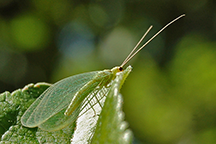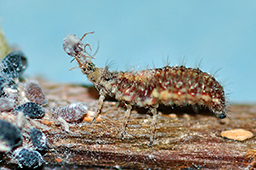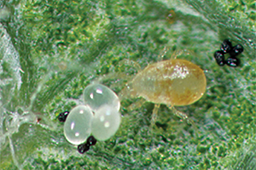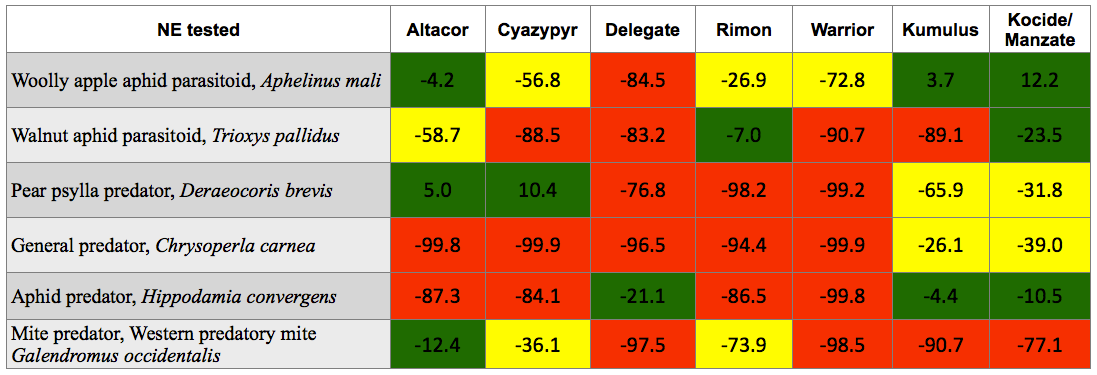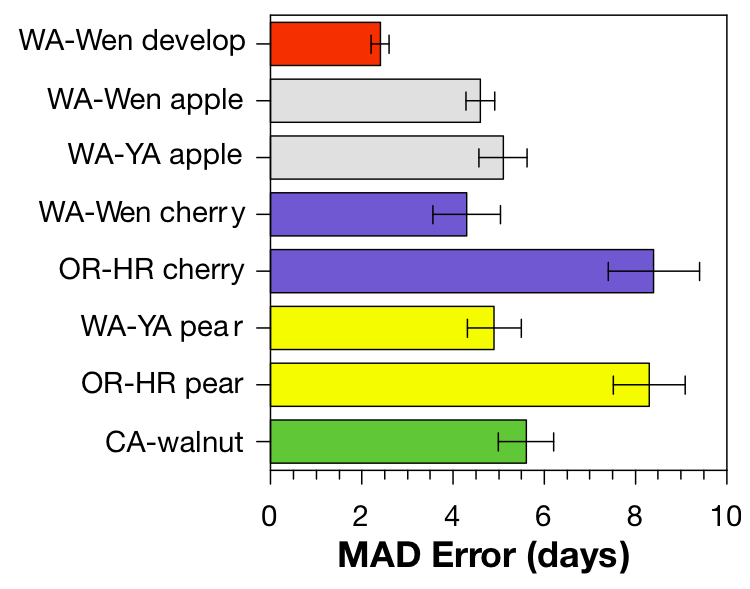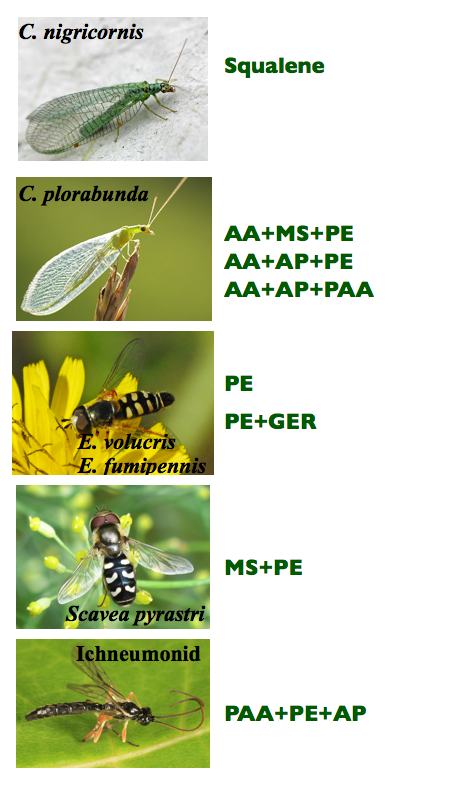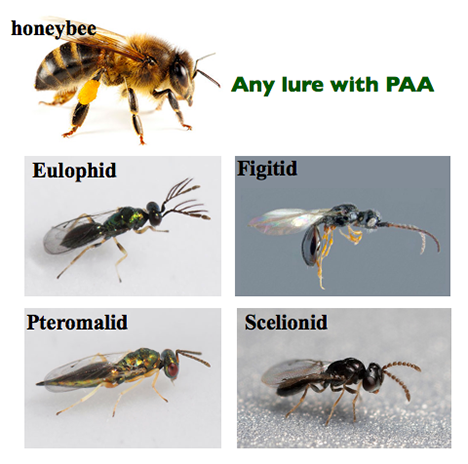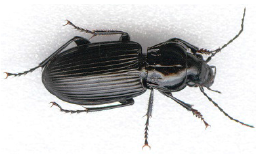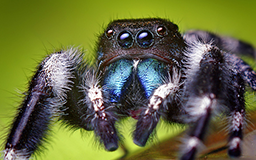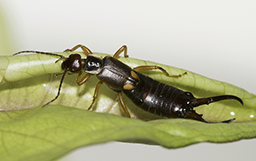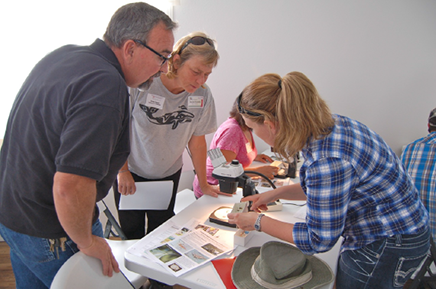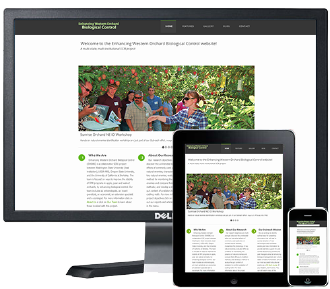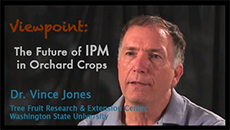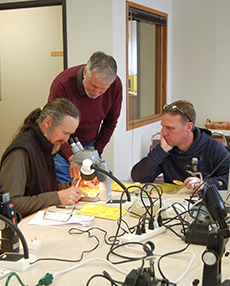Project Directors
Washington State University
- Vincent P. Jones (Project Director)
- Jay F. Brunner (Executive Committee)
- Elizabeth Beers
- Karina Galardo
- Jessica Goldberger
University of California, Berkeley
- Nicholas J. Mills (Executive Committee)
Oregon State University
- Peter W. Shearer
- Steve Castagnoli
USDA-ARS Wapato
- Dave R. Horton
- Thomas R. Unruh
Advisory Group
California: Mike Devencenzi, Joseph Grant
(UCCE), Jed Walton, Dr. Marshall Johnson (UC Riverside, outside scientist), Carolyn Pickel and
Walt Bentley (UCIPM), Drs. Pete Goodell, Lucia Verela and Tunyalee Martin (UCIPM)
Oregon: Rich Garvin, Bruce Decker, Jeff
Olsen (OSU Extension)
Washington: Dan Flick, Nick Stephens, Karen
Lewis (WSU Extension), Dr. Doug Walsh (WSU, outside scientist)
Canada: Dr. Gary Judd (Agriculture and
Agri-Food Canada, outside scientist)
Project Goals
- Improve the long-term sustainability of the apple, pear and walnut industries in the western
US by enhancing biological control (BC) of pest insects and mites.
- Synthesize the information developed in this project along with existing information to
provide the outreach tools needed to bring about change in grower practices.
Objectives
- Evaluate the sublethal effects of newer pesticides on key natural enemies in laboratory and
field assays in apple, pear, and walnut orchards.
- Characterize natural enemy phenology, including timing of emergence from overwintering
areas, entry into orchard, and development within the orchard.
- Evaluate attractants as natural enemy monitoring tools and compare them to traditional
methods.
- Develop molecular and video methods to monitor predation of codling moth.
- Conduct economic analyses to determine long-term costs associated with IPM programs with and
without various levels of biological control.
- Survey clientele to identify optimal ways to present information that will lead to quicker
adoption of new technologies; synthesize existing and new information to provide real-time
support for pest control decisions by stakeholders.
Over, but not done
Our project officially ended on 31 August. However, the official end is not the end of the
project and we have leveraged the SCRI funding well beyond the initial 1:1 match, with at least
an additional $1.8 M in new grant funds to expand on the original objectives and also to bolster
the outreach efforts.
For this progress report, we will provide a short overview of the
accomplishments for each objective, as well as showing some of the exciting new research and
extension directions that have been taken by some of our project directors. We also provide a
comprehensive list of publications, presentations, leveraged grants, and the training
opportunities that this SCRI grant has helped fund or that is an outcome of the leveraged
funding. We think that our productivity has been extraordinary, with 92 presentations, 31
additional symposia presentations (with 9 more coming in 2014), 21 popular articles, 26
peer-reviewed articles in print or in press, and a special issue of the journal Biological
Control that will have 14 additional peer-reviewed articles, a two-day short course presented at
3 locations over video conference, more than twelve 2-4 hour training courses on natural enemies
and a state of the art web site that pulls all this together
(enhancedbiocontrol.org).
We hope you enjoy the report and find our results and new directions to
be a clear indication of our passion for both basic and applied research, the excellence of our
team, and the importance of taking a broad and fresh approach to integrating biological control
into normal orchard management programs.
For more information on this project and our accomplishments, please
visit our web site (enhancedbiocontrol.org) and feel free to contact our project
directors.
Acknowledgments
Matching Funds Sources
- Washington Tree Fruit Research Commission
- Washington State Commission on Pesticide Registration
- California Walnut Board
- Hood River Pear Growers
- Washington State University
- Oregon State University
- University of California, Berkeley
- USDA-ARS Yakima Ag. Research Lab
Grower Cooperators
- Walnut growers in Suisun Valley and Davis
- Oregon Pear Growers in Hood River
- Washington apple growers in Quincy, Bridgeport, Frenchman Hills, Yakima, and Wapato
Participating Research Personnel
Although the project directors are ultimately responsible for the work
done in this project, there is also a key group of post-doctoral research scientists and
technical support personnel that have been essential to our project through their dedication and
hard work. We gratefully acknowledge their efforts to make the project a success:
Mills Lab (UC Berkeley) Obj. 1-3
- Kevi Mace-Hill
- Laura Jones
- Lisa Fernandez (Grad. Student)
Shearer Lab (OSU) Obj. 1-3
- Kaushalya Amarasekare (Post-Doc. Scientist)
- Amanda Borel
- Preston Brown
Horton & Unruh Labs (USDA) Obj. 1-4
- Eugene Miliczky (Post-Doc. Scientist)
- Merilee Bayer
- Deb Broers
- Francisco De La Rosa
Beers Lab (WSU) Obj. 1
Brunner Lab (WSU) Obj. 6
Goldberger Program (WSU) Obj. 6
- Nadine Lehrer (Post-Doc. Scientist)
- Emily Green-Tracewicz (Grad. Student)
Gallardo Program (WSU) Obj. 5
- Qianqian Wand (Grad. Student)
Jones Lab (WSU) Obj. 2,3,6
- Andrea Bixby-Brosi (Post-Doc. Scientist)
- Ute Chambers (Post-Doc. Scientist)
- Angela Gadino (Post-Doc. Scientist)
- Shaun Steffan (Post-Doc. Scientist)
- Callie C. Baker
- Stacey McDonald
- Tawnee D. Melton
- Brad Petit
- Teah Smith (Grad. Student)
- Nik Wiman (Grad. Student)
Lacewing larva eating aphid
Convergent ladybird beetle
Western predatory mite and mite eggs
Mills, Beers, Shearer, Unruh
Pesticides Influence BC Success
This objective has successfully characterized the potential disruptive
effects of seven different pesticides used for management of codling moth and diseases on a set
of natural enemies that contribute to the management of secondary pests in western apple, pear
and walnut orchards. Detailed laboratory tests designed to integrate both acute and sublethal
effects of pesticides on natural enemies led to the development of a simple visual chart
summarizing the relative compatibility of each pesticide with natural enemies (below;
enhancedbiocontrol.org/pe.html). Follow-up studies in apple, pear and
walnut orchards were used to confirm the strongest disruptive effects seen in the laboratory
tests on the ratio of natural enemies to secondary pests, which is a useful index of biological
control activity in the field. This information has already been incorporated into the decision
making of a number of leading pest managers throughout the region, and is being used in
educational programs associated with the project. We anticipate this information will result in
enhanced conservation of biological control agents in western orchards and reduce the need for
pesticide applications against secondary pests in these crops.
Benefits to Science and the Agricultural Industries
The accomplishments from the project include significant advances in
both science and industry application. From a science perspective, the project has generated the
first larger scale application of life table statistics to the laboratory assessment of
pesticide risk to natural enemies and provides a framework of standardized protocols for
rigorously testing pesticide selectivity. Benefits to the tree crop industries have been
twofold: First, growers and pest managers have become increasingly aware of the importance of
the biological control services that natural enemies can provide if not disrupted by
indiscriminate use of pesticides. Secondly, this awareness has encouraged them to question
whether changes in pesticide registration in these crops could be responsible for the novel
secondary pest complexes that have arisen in recent years. Consequently, this has led to a
series of new industry-sponsored research projects in all three states that are geared toward
enhancing the role of biological control in the management of secondary pests such as aphids,
pear psylla, and spider mites.
Percentage change in the population size of treated
populations compared to untreated controls after one generation, estimated from laboratory life
table bioassays. Green cells show <25% reduction, yellow have 25-75% reduction, and red have
>75% reduction.
The full inter-active table can be viewed at:
enhancedbiocontrol.org/PE.html
Jones, Mills, Shearer, Horton, Unruh
Knowing Phenology
Improves Management Options
Phenology models have been developed for two lacewings (Chysopa
nigricornis, Chrysoperla plorabunda) and a syrphid fly (Eupeodes fumipennis), and we are working
on at least two more. There is more data from apple orchards than all other crops, so we
developed the models using a subset of the apple data, and then validated the model using the
remainder of the apple data. The apple models were then tested in cherry, pear, and walnut
orchards to check for significant departure. Our average error with the models for the lacewing
Chrysopa nigricornis was similar in the two different areas of Washington tested, and
California, but were roughly 40% higher in Oregon (HR, figure on right). We are not sure why the
Oregon data had higher errors, but it is not related to differences in crops, since both cherry
and pear orchards in Washington fit the apple data similarly to the apple validation data. We
are currently evaluating the different spray programs to see if that explains the differential
errors in Oregon.
Benefits to Science and the Agricultural Industries
The phenology models for natural enemies are merely extensions of the
theory used to to develop phenology models for pest insects. However, they are an advance in the
sense that we found that the phenology in our systems could be predicted solely by temperature
accumulations, and did not require information on the host or prey populations levels. We also
found that a single model for each natural enemy had similar accuracy in all crops, except in
situations where pesticide use was excessive
The models provide the industries precise information on when
different natural enemies occur. In particular, we found that the lacewing, Chrysoperla
plorabunda and the syrphid flies (Eupeodes fumipennis and Eupeodes volucris) occur much earlier
in the season than previously expected. Our data suggest that we need to re-consider the
pesticides used, timing, and the particularly the delayed dormant sprays in all three crops.
Ultimately, we expect that we can use our data from this and leveraged projects to generate at
least five phenology models that are important to a range of our key pests in western orchards.
These models will be be delivered through the WSU-Decision Aid System and provided to the
researchers in Oregon and California for implementation in those states.
Mean absolute deviation error for the C. nigricornis model. Wen develop (red
bar) is the Wenatchee apple data (2009) used to develop the model, all other data is completely
independent and used to validate the model. YA - Yakima, HR-Hood River, Wen - Wenatchee.
Jones, Mills, Shearer, Horton, Unruh
Improved Monitoring Tools Make Biocontrol
Visible
The work performed in this objective makes our project the best source of
information for the effect of a wide range of floral volatiles and herbivore-induced plant volatiles
on natural enemies on different crops in widely separated locations. In addition, the factorial
design of our experiments allowed us to evaluate how different potential attractants work together
and give us a much more complete picture of how to combine several different volatile components
together to make lures that are not only more attractive, but also more selective for different
natural enemy groups. We found that 2-phenyl-ethanol (PE) was highly attractive to several species
of syrphid species, and some selectivity between species was possible by adding either methyl
salicylate (MS) or geraniol (GER). Lacewings (Chrysoperla plorabunda) responded strongly to
a variety of volatiles and optimal attraction required lures combining three different volatiles.
However, because of interactions between the different volatiles, there were multiple combinations
that provided the same response. Acetaphenone (AP) was important for C. plorabunda, but
only when mixed with other components. A broad range of Hymenopteran taxa responded to virtually any
lure combination that contained phenylacetaldehyde (PAA) as one component.
Benefits to Science and the Agricultural Industries
Our studies showed an astonishing variety of natural enemies could be
found at various times and abundances in agro-ecosystems. For example, in apple we regularly
monitored >120 different natural enemies. The traps are very sensitive indicators of species
presence and abundance that may change our basic understanding of population interactions. Our
studies also showed that particular lure combinations work regardless of the crop system, which
means that our research should translate to other crop systems which often share similar generalist
natural enemies. The discovery that PAA was attractive to all hymenopterans (including honeybees)
makes that compound a particularly powerful tool for studying ecosystem function because of the
importance of the parasitic Hymenoptera in regulation of a wide range of insect pests.
From the standpoint of benefit to the industries, we now have sensitive
traps that work for monitoring a range of natural enemy groups important in apple, cherry, pear, and
walnut orchards in the western region. These traps can provide the information on natural enemy
abundance throughout the season (useful in model development (objective 2)), and for understanding
the effects of different control tactics on natural enemy population dynamics. Our research also
showed that syrphid flies and lacewings could be used as indicator species to help simplify trap use
for pest management purposes.
We also worked with the Objective 6 group to put out grower/consultant
trials in Washington and Oregon of the squalene lure, which attracts the lacewing Chrysopa
nigricornis. These trials were to familiarize participants with the lures and compare
different management tactics on the lacewing.
Unruh
Three
Predator Groups are Dominant
Previous studies suggested that predation rates on mature codling moth
larvae were 30 – 40% when pesticide use was moderate. Here we designed a study to identify which
predator groups contribute most to codling moth mortality. Molecular gut content analysis was chosen
because predators usually eat their prey and leave little visual trace of their activities. Our
detection of codling moth DNA in predators provided a semi-quantitative measure of what proportion
of each predator group had recently fed on codling moth. The results are conservative because
digestion of the codling moth (and consequently their DNA) within the predator limits detectability
to just a few days. Even so, we found earwigs, spiders, and carabid ground beetles were important
due to their abundance and high feeding rates on codling moth (right).
Percentage of the total number of predator gut
content samples that tested positive for codling moth from seven orchards over a three year
period.
Benefits to the Agricultural Industries
Molecular gut content analysis of prey DNA is not new to science, however
it is expensive. One technique developed during this grant has streamlined and reduced the cost of
sample processing that will allow future studies to analyze significantly more specimens. As
agricultural entomologists, we generally know which groups of predators were likely to be important
but the activity by earwigs was both a surprise and a minor concern for some members of the
industry. In some apple varieties, earwigs can sporadically cause minor fruit damage. Earwigs are
well known to be important predators of woolly apple aphid, an increasingly important pest in newer
apple plantings. Future studies to evaluate how earwigs may affect fruit damage compared to their
contribution to overall biological control will be important knowledge for the design of sustainable
IPM programs in tree fruits.
Gallardo, Brunner, Castagnoli, Grant
What is
the Cost of Enhanced Biocontrol?
Benefits to the Agricultural Industries
The economic analysis showed that both apple and pear growers were willing
to pay extra for insecticides that would preserve natural enemies. Surveys showed that apple growers
were willing to pay $26.60/acre to decrease toxicity to natural enemies, $61.83/acre to be less
toxic to wildlife and $43.10 to decrease toxicity to aquatic organisms. Pear growers showed
different trends with a willingness to pay $33.37/acre to decrease toxicity for natural enemies,
$25.28/acre for decreased toxicity to wildlife and $19.68/acre for reduced toxicity to aquatic
organisms.
A second analysis focused on how the use of pesticides disruptive to
natural enemies affected costs of controlling secondary pests. Examination of spray records for
seven apple orchard operations in Washington found that for every $1 spent on insecticides that were
toxic to natural enemies, an additional $0.52 was spent on secondary pests. Similarly, analysis of
the spray records for 10 pear orchards in the Hood River of Oregon showed that for every $1 spent on
disruptive materials that $0.47 was required to control secondary pests.
Both of these studies show that economic incentives
exist to conserve natural enemies and that growers and IPM practitioners recognize and are willing
to pay to enhance biological control.
Goldberger, Brunner, All PD's
Getting
the Results to the Users
Benefits to the Agricultural Industries
A large amount of this project’s resources were dedicated to outreach
activities, highlighting the importance the project participants put on this aspect of the project.
Without effective outreach activities the results generated by projects such as this one generate
new scientific information, but do little to change perceptions and practices of stakeholders. The
goal of the outreach objective was not just to develop knowledge and technology for the apple, pear
and walnut industries, but to integrate this information with older information and deliver it in a
way that would impact their decision-making and management practices.
In the final year of our project we focused our activities in two major
areas, hands-on mini-workshops and further development of web resources. We knew from research that
students retain new information better when they are actively involved in the learning process.
Therefore, the hands-on mini-workshops involved meeting with small groups from key industry
organizations, especially those shown to be early adopters of new knowledge and technology, were
conducted in an engaging and interactive way. We held 10 mini-workshops over the winter of 2012/13
that included a total of 175 participants. We anticipate more rapid adoption of basic and new
biocontrol information and practices through these hands-on educational activities. For the
workshops, we developed hand-out materials including natural enemy fact sheets as well as a 19 x
13-inch natural enemy wall poster, which has been very popular with workshop participants and at
grower meetings. These hand-out materials can also be downloaded from our project website.
Web Resources – a Legacy for the Future
Preserving our project results and providing useful resources for our
stakeholders has been a top priority of this project from the start. We’ve tried to stay ahead of
the changes in digital technology by frequently updating our web platform and it is currently
available on nearly any platform/device combination. The website (enhancedbiocontrol.org) is a
repository of all of the research results from the project’s different objectives in many forms. For
Washington growers, the information generated by the project is also being incorporated into the
WSU-Decision Aid System (das.wsu.edu) which is used to make IPM decisions on >80% of Washington tree
fruit acreage.
In addition to comprehensive reports, the project website contains a
listing of all related publications with links for reading, printable identification guides,
workshop handouts, viewable presentations, natural enemy image galleries, videos of techniques and
collaborator insights, and an interactive pesticide effects table developed from the results
obtained in Objective 1, as well as a compiled database of pesticide effects on natural enemies that
will be placed both on our project web site and the WSU-DAS website. The website will remain
accessible well beyond the end of this project and thanks to new leveraged funding, we will continue
to update and add features making it an enduring legacy.
Many of our articles, presentations and posters are available to read
on-line or download as PDFs. Look for them under the web site menu heading Features: Resources.
2013 Presentations
- Amarasekare KG, PW Shearer. Comparing effects of newer insecticides on two green lacewings
species, Chrysoperla johnsoni and Chrysoperla carnea (Neuroptera:
Chrysopidae). Orchard Pest and Disease Management Conference, Portland, OR.
- Astorino J, R. Torcasso, J Goldberger. The influence of social networks, environmental
consciousness, and farm structure on the adoption of a sustainable agriculture practice. Joint
Meeting of the Agriculture, Food and Human Values Society and Association for the study of Food
and Society. East Lansing, MI.
- Beers EH. IPM Grab Bag: Current Insect Pest Management Issues in Tree Fruits. 67th Lake Chelan
Horticultural Day, 21 Jan., Chelan, WA.
- Beers EH. Current Insect Pest Management Issues in Apples – New and Old. Apple Day, 22 Jan.,
Wenatchee, WA.
- Beers EH. Woolly Apple Aphid: All you wanted to know, and more…. Northwest Wholesale
Recertification Day, 15 Jan., Wenatchee, WA. (invited speaker).
- Chambers U, L Garcia, F. Sarmiento. Enhancing biological control in western orchards (Mejorando
el control biologico en huertos del oeste). Wash. State Hortic. Assoc. Ann. Meeting, Wenatchee,
WA. 2-4 Dec. 2013. (invited speaker).
- Jones VP. Alternative methods of codling moth control. Columbia Fruit IPM meeting. 13 Feb.
(invited speaker).
- Jones VP, J Brunner, EH Beers, K Gallardo, NJ Mills, PW Shearer, S Castagnoli, DR Horton, TR
Unruh, J Goldberger, U Chambers, A Gadino, A Bixby-Brosi, K. Amarasekare. Enhancing biological
control in western orchards: A summary of new information and directions for future research.
Wash. Tree Fruit Research Commission Crop Protection Meeting. 30 Jan. (invited speaker).
- Jones VP, U Chambers, A Bixby-Brosi. Enhancing BC in apples: how do conventional and organic
systems differ? Wash. Tree Fruit Research Commission Crop Protection Meeting. 30 Jan.
- Jones VP, A Gadino, J Brunner. Models to assess pesticide impact on CM, OBLR, and Chrysopa
nigricornis. Wash. Tree Fruit Research Commission Crop Protection Meeting. 30 Jan.
- Jones VP. Biocontrol research in the last five years and the next five. Wash. State Hortic.
Assoc. Ann. Meeting, Wenatchee, WA. 2-4 Dec. 2013. (invited speaker).
- Mills, N.J. Selective pesticides and biological control in walnut pest management. California
Walnut Board Annual research conference, Bodega Bay, CA. Jan. 25.
- Shearer PW. Enhancing biological control in western USA pear orchards. Department of
Horticulture. Oregon State University, Corvallis, OR. Mar. 4. (invited seminar).
- Unruh TR. Major predators of codling moth: Earwigs can be your friend. Wilbur Ellis, Organic
pest consultants and growers meeting, Prosser, WA, Dec.
2014 Symposia
We organized symposium entitled “Progress towards integration of conservation biological control
in Western apple, pear, and walnut orchards” on our project for the Pacific Branch of the
Entomological Society of America that will be presented at the Tuscon meetings in 7-10 April with
the following titles and speakers:
- Jones VP. Enhancing biological control in Western apple, pear, and walnut orchards.
- Jones VP, NJ Mills, DR Horton, TR Unruh E. Milickzy, PW Shearer. Evaluating floral lures and
herbivore-induced plant volatiles for monitoring natural enemies and improving biological
control in western orchards
- Mills NJ. Comparative analysis of pesticide effects on natural enemies in Western orchards: a
synthesis of laboratory bioassay data.
- Beers EH. Natural enemies and non-target effects: Do lab results predict field results?
- Unruh TR. A broader approach to gut content analysis for better understanding of predator
diets.
- Hansen, M. Easier access to MRLs. Visit the DAS web site. Good Fruit Grower. March 15, 2012.
- Warner, G. Let natural enemies play a role. IPM means managing pests, not eliminating them. Good
Fruit Grower. February 1, 2012
- Shearer PW, K Amarasekare, S Castagnoli. Assessing conservation biological control in
Mid-Columbia pear orchards.
- Brunner JF, K Gallardo. Assessing the economic value of biocontrol in western orchard systems.
- Goldberger J. Who uses biological control and why? Evidence from surveys of walnut and pear
growers in the western US.
- Gadino A. Developing an outreach program for a regional, multi-year grant: lessons learned and
future directions.
- Chambers U. Making new information accessible to the stakeholders through websites, decision
support systems and smartphone apps.
2013 Symposia
- Jones VP, N Mills, J Brunner, E Beers, U Chambers, A Gadino, D Horton, P Shearer, S Castagnoli,
K. Amarasekare, T Unruh. Enhancing biological control in Western orchards: an overview of a five
year effort. Pacific Branch Entomol. Soc. American. Lake Tahoe, NV. 7-10 Apr.
- Jones VP. C.W. Woodworth Award Presentation. Pacific Branch Entomol. Soc. American. Lake Tahoe,
NV. 7-10 Apr.
2013 Posters
- Amarasekare KG, PW Shearer. Effects of newer insecticides on the green lacewing Chrysoperla
carnea. Centennial Celebration and Annual Open House - Research Highlights. Mid-Columbia
Agricultural Research and Extension Center, Oregon State University, Hood River, OR.
- Unruh TR. Measuring predation on codling moth. Western Orchard Pest and Disease Conference,
11-13 Jan. Portland, OR.
Mics. Outreach
- Amarasekare KG. KIHR- (Local Radio Station, Hood River, OR) - Radio Talk on enhancing biological
control in tree fruit orchards. 5 Jan.
- Shearer PW. KIHR - (Local Radio Station, Hood River, OR). Radio Talk Biological control; using
good bugs to take care of bad bugs
- Jones VP. The future of IPM in orchard crops. 15 min. video, part of the series by the
University of California program on Extending Orchard IPM knowledge in California. 11 April
2013. (video
link)
Meetings Attended/Hosted
- Identification of natural enemies in tree fruit orchards. Annual Sunrise Research Orchard Field
Day, Wenatchee, WA. 7 August 2013
- Mobile Predator Lab. Training workshop, Qualls Bayer Acre Day, Ephrata, WA. 17 July 2013.
- Biological Control Basics & Natural Enemy ID. Training workshop, Wenatchee, WA. 7 March 2013.
- Biological Control Basics & Natural Enemy ID. Training workshop, Wenatchee, WA. 5 March 2013.
- Biological Control Basics & Natural Enemy ID. Training workshop, Wenatchee, WA. 27 February
2013.
- Biological Control Basics & Natural Enemy ID. Training workshop, Cashmere, WA. 14 February
2013.
- Biological Control Basics & Natural Enemy ID. Training workshop, Wenatchee, WA. 13 February
2013.
- Biological Control Basics & Natural Enemy ID. Training workshop, Yakima, WA. 5 February 2013.
- Biological Control Basics & Natural Enemy ID. Training workshop, Wenatchee, WA. 24 January
2013.
- Biological Control Basics & Natural Enemy ID. Training workshop, Chelan, WA. 16 January 2013.
Popular Articles
- Chambers U, V Jones, A Gadino, W Jones, N Mills, J Brunner. Part 1. Enhancing Biocontrol:
Overview. Good Fruit Grower. Feb. 1, 2013.
- Bixby-Brosi A, V Jones, D Horton, T Unruh, N Mills, P Shearer, J Brunner. Part 2. Enhancing
Biocontrol: Natural Enemy Inventory. Good Fruit Grower. Feb. 15, 2013.
- Gadino A, V Jones, N Mills, P Shearer, T Unruh, J Brunner. Part 3. A New Tool for IPM: Natural
enemy models. Good Fruit Grower. March 1, 2013.
- Gadino A, T Unruh, J Brunner. Part 4: Codling moth: It's what's for dinner. Good Fruit Grower.
March 15, 2013.
- Gallardo K, and J Brunner. Part 5: Calculating the value of biological control. Good Fruit
Grower. April 1, 2013.
- Chambers U, N Mills, E Beers, T Unruh, P Shearer, J Brunner, K Amarasekare and V Jones. Part 6:
Your management program matters. Good Fruit Grower. April 15, 2013.
- Goldberger J, W Jones and N Lehrer. Part 7: Pear growers surveyed on biological control. Good
Fruit Grower. May 1, 2013.
- Jones W, A Gadino, U Chambers, J Brunner. Part 8: Outreach: the final goal. Good Fruit Grower.
May 15, 2013.
2014 Refereed Publications
We have contacted the journal Biological Control and arranged for the
publication of a special issue with 14 different articles (below) all by our team members. These
articles will go through the normal peer review process and be published together in a single issue
devoted to our project. This method of publication brings our work together in a single location
available in the best libraries in the world as well as available on the internet.
- Jones VP, NJ Mills, JF Brunner, DR Horton, EH Beers, TR Unruh, PW Shearer, J Goldberger, K
Gallardo, S Castagnoli, N Lehrer, SA Steffan, KG Amarasekare, U Chambers, AN Gadino. 2014. From
planning to execution to the future: An overview of a concerted effort to enhance biological
control in Western apple, pear, and walnut orchards.
- Amarasekare KG, PW Shearer, NJ Mills. 2014. Testing the selectivity of pesticide effects on
natural enemies in laboratory bioassays.
- Mills NJ, EH Beers, PW Shearer, TR Unruh, KG Amarasekare. Comparative analysis of pesticide
effects on natural enemies in Western orchards: a synthesis of laboratory bioassay data.
- Shearer PW, KG Amarasekare, EH Beers, NJ Mills, VP Jones. 2014. Large-plot field studies to
assess impacts of newer insecticides on non-target arthropods in Oregon pear orchards.
- Beers EH, NJ Mills, PW Shearer, DR Horton, E Milickzy, KG Amarasekare. 2014. Non-target effects
of orchard pesticides on natural enemies: lessons from the field and laboratory.
- Jones VP, CC Baker, AJ Bixby-Brosi. 2014. Evaluating release rates and longevity of natural
enemy attractant lures.
- Jones VP, DR Horton, NJ Mills, TR Unruh, CC Baker, TD Melton, E Milickzy SA Steffan, PW Shearer,
KG Amarasekare. 2014. Evaluating herbivore-induced plant volatiles and floral volatiles for
monitoring natural enemies in apple, pear and walnut orchards.
- NJ Mills, Jones VP, DR Horton, TR Unruh, CC Baker, SA Steffan, TD Melton, PW Shearer, KG
Amarasekare, E Milickzy. Using herbivore-induced plant volatiles and floral volatiles to attract
natural enemies for studies of ecosystem structure and function.
- Jones VP, NJ Mills, PW Shearer, TR Unruh, DR Horton, E Milickzy, TD Melton, CC Baker. 2014.
Using natural enemy lures to develop phenology models for IPM purposes: an example using Chrysopa
nigricronis Burmeister (Neuroptea: Chrysopidae).
- Unruh TR, E Milickzy, DR Horton . 2014. The spider fauna using codling moth, Cydia
pomonella, in apple orchards as determined by molecular gut content analysis.
- Gallardo K, JF Brunner, S Castagnoli, NJ Mills, J Grant. 2014. Capturing the economic value of
biological control.
- Goldberger J, N Lehrer, JF Brunner, NJ Mills. 2014. Biological control adoption in western
orchard systems: Results from grower surveys.
- Jones WE, U Chambers, AN Gadino, JF Brunner, VP Jones . 2014. Web-based outreach for orchard
management decision-makers.
- Gadino AN, JF Brunner, U Chambers, S Castagnoli, WE Jones. 2014. A perspective on the extension
of research-based information to orchard management decision-makers: Successes and failures and
potential future directions.
2013 Refereed Publications
- Amarasekare KG, PW Shearer. 2013. Life history comparison of two green lacewings species, Chrysoperla
johnsoni and Chrysoperla carnea (Neuroptera: Chrysopidae). Environmental
Entomology. (in press).
- Amarasekare KG, PW Shearer. 2013. Comparing effects of insecticides on two green lacewing
species, Chrysoperla johnsoni and Chrysoperla carnea (Neuroptera:
Chrysopidae). J. Economic Entomology 106:1126-1133).
- Amarasekare KG, PW Shearer. 2013. Laboratory bioassays to estimate the lethal and sublethal
effects of various insecticides and fungicides on Deraeocoris brevis (Hemiptera:
Miridae). J. Economic Entomology. 106: 776-785.
- Beers EH. 2012. Effect of trap color and orientation on the capture of Aphelinus mali
(Haldeman) (Hymenoptera: Aphelinidae), a parasitoid of woolly apple aphid (Hemiptera:
Aphididae). J. Econ. Entomol. 105: 1342-1349.
- Gallardo RK, Q Wang. 2013. “Willingness to Pay for Pesticides’ Environmental Features and Social
Desirability Bias: The Case of Apple and Pear Growers.” Journal of Agricultural and Resource
Economics 38:124-139.
- Gallardo RK, D Toro-Gonzalez, JR Goldberger, N Lehrer, JF Brunner. “Factors Affecting the
Adoption of Integrated Pest Control, An Application to the Pacific Northwest Pear Industry.”
Journal of Agricultural and Resource Economics (submitted).
- Gontijo L, EH Beers, WE Snyder. 2013. Flowers promote aphid suppression in apple orchards. Biol.
Contr. (in press).
- Gontijo L, SD Cockfield, EH Beers. 2012. Natural enemies of woolly apple aphid (Hemiptera:
Aphididae) in Washington state. Environ. Entomol. 41: 1364-1371.
- Jones VP, R Hilton, JF Brunner, WJ Bentley, DG Alston, B Barrett, RA Van Steenwyk, LA Hull, JF
Walagenbach, WW Coates, TJ Smith. 2013. Predicting emergence of codling moth, Cydia
pomonella (Lepidoptera: Tortricidae) on a degree-day scale in North America. Pest.
Management Sci. (in press).
- Jones VP, NG Wiman. Age-based mating success in codling moth and obliquebanded leafroller. J.
Insect Sci. (in press).
- Pfannestiel RS, BE Mackey, TR Unruh. 2012. Leafroller parasisism across an orchard landscape in
central Washington and effect of neighboring rose habitats on parasitism. Biological Control.
62:162-172.
- Schmidt RA, EH Beers, TR Unruh, DR Horton. 2013. Releases of insectary-reared Galendromus
occidentalis (Acari: Phytoseiidae) in commercial apple orchards. J. Econ. Entomol. 106: in
press.
- Steffan SA, Y Chikaraishi, DR Horton, N Ohkouchi, ME Singleton, EJ Bosak, E Milicyky, DB Hogg,VP
Jones. 2013. Trophic hierarchies unmasked via amino acid isotopic analysis. PLOS ONE 8: 1-10.
- Wiman NG. VP Jones. 2013. Attack biology and egg maturation strategy of two tachinid parasitoids
of leafroller (Lepidoptera: Tortricidae) pests in tree fruit. Ann. Entomol. Soc. Amer. 106:
485-490.
- Wiman NG, VP Jones. 2013. Influence of oviposition strategy of Nemorilla pyste and Nilea
erecta (Diptera: Tachinidae) on parasitoid fertility and host mortality. Biol. Control
64:195-202. (online)
- Wiman NG, VP Jones. Sublethal effects of pyriproxyfen and methoxyfenozide on Nemorilla
pyste and Nilea erecta (Diptera: Tachinidae), parasitoids of leafrollers
(Lepidoptera: Tortricidae) in tree fruits. J. Pest Management Sci. (in press).
It’s more
than just what we started to do. Just a few examples:
Promoting biological control through hands-on and web-based training
course, mobile apps, and assisted technology transfer. JF Brunner, U Chambers, A Gadino.
WSDA-USDA Specialty Crop Block Grant. $155,743 (2013-2015).
This project will provide for more hands-on workshops as well as an online
course that will focus on the basics of biocontrol, key natural enemies in orchards, newly developed
tools to monitor and predict natural enemy presence, and pesticide effects on natural enemies; all
knowledge gained from this SCRI project. We will also create an innovative and user-friendly pest
and natural enemy identification guide available online and as a mobile app to complement the
on-line course. In addition, the funding will allow us to extend work performed over the past 2
years with IPM practitioners to evaluate new natural enemy monitoring tools in their orchards and
provide feedback. The new project’s outcomes have the potential to benefit the entire tree fruit
industry through increased awareness and utilization of biocontrol resulting in reduced pesticide
applications/costs and increased worker, food, and environmental safety.
Enhancing BC in apples: how do conventional and
organic systems differ? Jones VP, U Chambers. Washington Tree Fruit Research Commission.
$303,858 (2011-2013).
This project used the attractant lures developed in objective 2 of the
SCRI grant. We focused on the differences in the natural enemy complexes in paired organic and
conventional orchards. The data from this project were taken in the same manner as used in our
studies done in the SCRI grant in objective 2, which expands the data available to make natural
enemy models. The work done under this project also showed that we could use conventional pesticides
at low rates (10% field rate) with timing and treatment intervals similar to organic treatments and
still achieve commercially acceptable damage levels similar to either organic or conventional
programs. The low rate treatments had similar natural enemy abundance and diversity as the organic
treatments at a very low cost and with an 80% reduction in pesticides applied.
Enhancing tree fruit IPM decision-making through advances on WSU-DAS
and training of growers and pest management advisors. Jones VP, U Chambers, JF Brunner. Wash.
State Dept. Agric. SCRI block grant. $214,215 (2011-2014).
Developing new natural enemy and pest models for WSU-DAS. Jones
VP, U Chambers. Washington Tree Fruit Research Commission $151,497 (2013).
These two grants are aimed at improving the WSU-Decision Aid System (DAS),
by incorporating models developed using data from the the SCRI project and by collecting more data
to generate new models of not only natural enemies, but also pests. These grants also provided funds
to enhance our outreach efforts to users throughout the state of Washington, develop orchard
management systems to help minimize pesticide use in orchard systems, and to develop push
notifications so that growers are alerted immediately when critical IPM events occur or are
predicted to occur.
Models to assess pesticide impacts on codling moth,
obliquebanded leafroller, and Chrysopa nigricornis. Jones VP, A Gadino, JF Brunner. Washington
Tree Fruit Research Commission $226,690 (2012-2015).
This grant is a spinoff from Objective 1 of the SCRI grant. Both the large
scale field trials and the lab trials were difficult, very expensive, and prone to problems
associated with year-to-year variation in pest and natural enemy population levels. This leveraged
project uses field-aged residues to monitor how pesticides degrade over time and combines those data
with state-of-the-art demographic models that mimic the phenology found in the field. These models
then allow us to evaluate the effects of different treatment regimes for pests to evaluate the best
ways to reduce pest populations while preserving natural enemy populations.
Conservation biological control of pear psylla in
PNW pears. PW Shearer, KG Amarasekare. Washington Tree Fruit Research Commission. $ 71,571
(2013-2014).
This project is focused on evaluating if the use of mating disruption for
CM in pears allows improved biological control of pear psylla during the summer. It will use a
combination of the technologies developed in objectives 1-3 from our SCRI project to help tease
apart which natural enemies are more common and the best ways to conserve the natural enemies
important in pear psylla population suppression.
Full List of Leveraged Funding
- Beers EH. Biocontrol of woolly apple aphid. Washington Tree Fruit Research Commission.
$108,635. (2009-2011).
- Beers EH. Biocontrol of woolly apple aphid. Washington State Commission on Pesticide
Registration. $42,078. (2009-2011).
- Beers EH. Insectary plantings for natural enemies of woolly apple aphid. WSU BioAg
Program. $24,473. (2010-2011).
- Brunner JF, U Chambers, A Gadino. Promoting biological control through hands-on and
web-based training course, mobile apps, and assisted technology transfer. USDA-WSDA
Specialty Crops Block Grant Program. $155,743. (2013-2015).
- Jones VP, U Chambers, JF Brunner. Enhancing tree fruit IPM decision-making through advances
on WSU-DAS and training of growers and pest management advisors. Wash. State Dept. Agric.
SCRI block grant. $214,215. (2011-2014).
- Jones VP, U Chambers. Enhancing BC in apples: how do conventional and organic systems
differ? Washington Tree Fruit Research Commission. $303,858. (2011-2014)
- Jones VP, A Gadino, JF Brunner. Models to assess pesticide impacts on CM, OBLR, and C.
nigricornis. Washington Tree Fruit Research Commission $226,690. (2012-2015).
- Jones VP, U Chambers. Developing new natural enemy and pest models for WSU-DAS.
Washington Tree Fruit Research Commission $151,497. (2013).
- Jones VP, A Gadino. Evaluating low dose insecticide residues on codling moth flight and
behavior. Washington State Commission on Pesticide Registration. $21,438 (2013).
- Jones VP, SA Steffan. Enhancing biological control in cherries. Washington State
Commission on Pesticide Registration $23,189. (2010).
- Mills NJ, C Pickel, J Grant, SC Welter. Selective pesticides and biological control in
walnut pest management. California Walnut Board. $21,726. (2011-2012).
- Mills NJ. Spider mite management in Walnuts. California Walnut Board. $178.383.
(2013-2015).
- Shearer PW. Conservation biological control of pear psylla in PNW pears. Washington
Tree Fruit Res. Commission. $75,571. (2013-2014).
- Shearer PW, K Amarasekare, VP Jones, SA Steffan. Improving biological control of insect
pests of cherry. Washington Tree Fruit Research Commission $79,485. (2010-2011).
- Unruh TR, DR Horton, EH Beers. Efficacy and best practices for predator releases: lacewing,
beetles, and mites. Washington Tree Fruit Research Commission. $237,997. (2010-2012).



